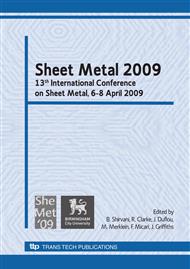p.373
p.381
p.391
p.401
p.413
p.421
p.429
p.439
p.449
A Neural Network Based Approach for the Design of FSW Processes
Abstract:
Friction Stir Welding (FSW) is an energy efficient and environmentally "friendly" welding process. The parts are welded together in a solid-state joining process at a temperature below the melting point of the workpiece material under a combination of extruding and forging. This technology has been successfully used to join materials that are difficult-to-weld or ‘unweldable’ by fusion welding methods. In the paper a neural network was set up and trained in order to predict the final grain size in the transverse section of a FSW butt joint of aluminum alloys. What is more, due to the relationship between the extension of the “material zones” and the joint resistance, the AI tool was able to furnish indications for the design of the welding process. Experimental tests and subsequent microstructure observations were developed in order to verify the numerical predictions.
Info:
Periodical:
Pages:
413-420
Citation:
Online since:
March 2009
Authors:
Price:
Сopyright:
© 2009 Trans Tech Publications Ltd. All Rights Reserved
Share:
Citation:


